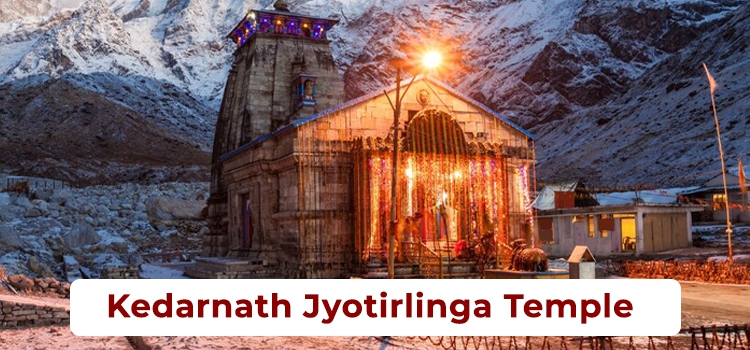Kedarnath Jyotirlinga Temple Timings, History, Pooja
Jyotirlinga means 'Lingam of light'. The Hindu deity, Shiva, is often represented in abstract form as the phallic-looking Lingam, as he is formless and transcendental and beyond all characteristics, especially gender.
The Lingam is often represented within the Yoni, a disc-shaped platform. The latter is its feminine counterpart and consists of a flat element, which is horizontal as opposed to the vertical Lingam. This also helps drain liquid offerings. Together, they signify the merging of micro cosmos and macro cosmos, the union of the feminine and the masculine, and the eternal process of creation and regeneration.
The Linga Purana says, "Shiva is signless, without color, taste, smell, that is beyond word or touch, without quality, motionless and changeless". The word lingam does not appear in the Rigveda or the other Vedas. Linga worship was not a part of the Vedic religion. It originated from a hymn in the Atharva Veda Samhita.

The Shiva Purana has a legend about the origin of Shiva’s phallic form. To test the devotion of some false sages, Shiva took the form of a hideous and naked ascetic, with ashes smeared all over his body and holding his penis. The sages could not recognize him, and they cursed Shiva, saying, “You are acting like a pervert. This is against the Vedic path. May your penis fall on the ground.”
The falling organ burnt everything in its path in all three worlds (hell, heaven, and earth). The sages sought help from Brahma.
He told them to pray to Parvati to take the form of a vaginal passage and perform a procedure, which involved reciting Vedic mantras and decorating the penis with flowers etc., to steady the penis. The pedestal shaped like a vagina and the phallus fixed therein represent the eternal creative forces.
The Shiva Purana also mentions the origin of the Shiva Lingam as the cosmic pillar (Stambha) of fire, which has no beginning or end. Shiva is depicted as emerging from the Lingam, proving his supremacy over Brahma and Vishnu.
The Sanskrit words jyotis means 'radiance,' and linga means 'sign'. In many temples in India, it is the Lingam rather than an idol of Shiva which is installed for worship. Many of these are Swayambhu or self-manifested.
As per the Shiva Purana, there are 64 original Jyotirlinga shrines in India. Of these, twelve are very holy. These are the Maha Jyotirlingams.
The Kedarnath Jyotirlinga Temple
The temple lies at an altitude of 3,583 m. It is 223 km from Rishikesh, and stands on the banks of the Mandakini river. The stone building’s builder and antiquity are unknown. “Kedarnath” means “lord of the field” and comes from the Sanskrit words ‘kedara’ and ‘natha’. The Kashi Kedara Mahatmya says that it is called so because it is the site of “the harvest of liberation”.
In November, during the winter season, Kedarnath sees heavy snowfall, and all routes will be closed. The sanctum is closed for 6 months. The idol of Shiva is taken from Garhwal (Kedarkhand) to Ukhimath, where worship will take place. It will be reinstated in Kedarnath during the first week of May. At this time, the temple doors open for worship as pilgrims gather from all over India. The sanctum will close during the week of Kartika, on the day of Bhai Dooj (October-November). It will reopen after Akshay Tritya (April-May).
The opening of Kedarnath Jyotirlinga temple from April to May is accompanied by grand celebrations. The temple's opening dates are announced on the occasion of Mahashivratri. Hordes of pilgrims flock to the temple on the opening day. There is a long, ceremonial Pooja after the shrine opens. The chief priest first takes blessing and view of the Lingam when it opens.
Kedarnath Temple Pooja and Rituals:
Mahabishekam Rudrabishekam – A Pooja to remove all sins. Laghu Rudrabishekam – A ritual to solve health and wealth-related problems or to eliminate the adverse effects of planets in the horoscope.
Shodasopachar Pooja
The evening Poojas take place between 6:00 pm to 07:30 pm. They are:
Shiva Sahasranamam Paath – Recital of the 1008 names of Shiva. Shiva Mahimastotra Paath – Recital of Stotrams, which have 16 syllables per stotra. They describe Shiva’s power and beauty.
History of the Kedarnath Jyotirlinga Temple
One account says that Shiva decided to live here as per the request of Nara-Narayana. When the Kurukshetra war ended, the Pandava brothers arrived here to meet Shiva on the advice of Sage Vyasa. They wished to apologize for having killed their kith and kin during the battle. But, Shiva did not wish to forgive them. So, he turned into a bull and hid among some cattle on the hill.
When the Pandavas found him, he tried to hide by immersing his head in the ground. But, one of the Pandavas caught him by the tail, and forced him to appear before them. So he had no choice but to forgive them. The Pandava brothers were the ones to build the first temple in Kedarnath. Shiva’s body parts then turned up in another four places. Together, these five places were called the five Kedaras, and the bull’s head appeared at Rudranath.
The Mahabharata does not mention Kedarnath. One of the earliest references is in the Skanda Purana, which has a story about the origin of the Ganges. It names Kedara (Kedarnath) as the site where Shiva released holy water from his matted locks of hair.
Hagiographies based on Madhava’s Sankshepa-shankara-vijaya claim that the 8th-century philosopher, Adi Shankara, died here. But, other hagiographies based on Anandagiri’s Prachina-Shankara-Vijaya, say that he died in Kanchi. One can find the ruins of a monument where Shankara supposedly met his death in Kedarnath. In the 12th century, Kedarnath was a major pilgrimage center and was mentioned in Kritya-kalpataru, written by the minister of Gahadavala, Bhatta Lakshmidhara.
The English mountaineer, Eric Shipton (1926), has said that “several hundred years ago”, the Kedarnath temple had no local priest. It was the priest of the Badrinath temple who officiated in both temples, traveling between the two locations daily.
When to Visit?
Kedarnath Dham is open for worship for only a few months, owing to the extreme weather conditions. The climate here is cold for most of the year. Even in summer, it is very cold at night.
Summer is the ideal time to visit the temple. The season is from April to June. One can revel in the beautiful views and enjoy the fresh air. One needs to wear warm clothes even in summer.



















